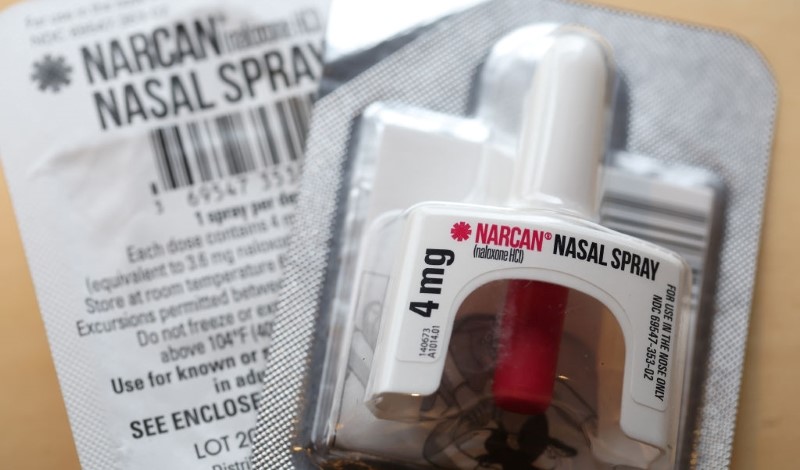
FDA approves first over-the-counter treatment to combat the opioid overdose epidemic.
Over 100,000 people died from drug overdoses in 2021. Despite escalation of the opioid public health crisis over the past few years, many communities still struggle to access overdose treatment. The U.S. Food and Drug Administration (FDA) has taken action to confront this issue.
Last month, FDA approved the first over-the-counter naloxone nasal spray, known as Narcan. Narcan reverses the effects of overdose and restores normal respiration, making it the standard treatment for opioid overdose. Narcan’s over-the-counter approval marks the culmination of a hard-fought battle to expand access to overdose treatment, but also presents new challenges for regulators working to control the overdose epidemic.
FDA approved Narcan initially as a prescription drug in 2015, but barriers to accessing the drug impeded its distribution to individuals experiencing an overdose. Although emergency medical personnel and first responders have been equipped with Narcan to prevent opioid overdose deaths, by the time they reach a person having an overdose it is often too late. Family, friends, and bystanders are usually best positioned to save the life of someone at risk of an opioid overdose, but they have struggled to access the drug.
State and local efforts to expand access to Narcan have made a positive impact, but they remain limited. For instance, overdose education and naloxone distribution programs dispense Narcan to community members. Homeless shelters, libraries, emergency departments, substance use disorder treatment programs, and other community organizations participate in these overdose response efforts. Studies show that these programs prevent overdose deaths and are cost-effective, but they often fail to reach the highest-risk populations.
Pharmacies have also helped to expand access to Narcan, but similarly with limited effect. Many state laws enable pharmacists to dispense Narcan under a standing order, which does not require a physician’s prescription to fill individual requests. Studies examining these state laws, however, have found that standing orders had little effect on overall overdose deaths.
Despite efforts to provide access to prescriptions of Narcan, factors such as varied out-of-pocket costs, low consumer acceptance, and unpredictable pharmacy availability have caused the crisis to persist. In 2019, FDA took steps to support development of an over-the-counter Narcan product. By designing, testing, and validating a new, user-friendly Narcan label, FDA aimed to encourage manufacturers to pursue approval of over-the-counter Narcan products.
Nonetheless, the COVID-19 pandemic and increasing access to fentanyl—an opioid 50 times stronger than heroin and 100 times stronger than morphine—have further exacerbated the overdose crisis. The Biden Administration responded by permitting the use of federal funding for state and local public health departments to purchase Narcan and prioritizing review of nonprescription Narcan applications. In addition, the Biden Administration has supported state development of Narcan distribution plans and issued guidance aimed at facilitating distribution of Narcan to at-risk populations.
But FDA also stepped in recently to answer experts’ calls for additional overdose prevention strategies.
FDA’s decision in March to approve over-the-counter sales of Narcan paves the way for its direct sale to consumers in grocery stores, gas stations, and drug stores. In turn, this decision facilitates greater access to Narcan and aims to reduce opioid deaths nationally.
In addition to approving Narcan for over-the-counter sales, FDA has released an overdose prevention framework to guide the agency’s efforts to reduce opioid overdose. The framework outlines four key priorities: supporting primary prevention; encouraging harm reduction; advancing evidence-based treatments for substance use disorders; and protecting the public from unapproved, diverted, or counterfeit drugs. For FDA, Narcan’s over-the-counter status is but one important harm reduction intervention among several that aim to decrease national overdose deaths.
The price of Narcan, however, still poses a barrier, especially for under-resourced communities. Currently, a two-dose box of Narcan costs about $40 at Walgreens. Although Medicaid and most private insurance cover prescription Narcan completely or, at most, require a $10 out-of-pocket payment, public and private insurance programs often do not cover over-the-counter medicines.
Whether insurance programs will cover over-the-counter purchases of Narcan may determine the ultimate impact that FDA’s approval will have on reducing opioid overdoses. Although health economists remain hopeful that increased volume and competition will reduce Narcan prices over time, the uninsured population may still struggle if they cannot afford this medication.
Stigma may also impede access to over-the-counter Narcan. Some pharmacists have reportedly refused to stock Narcan because they do not want to engage with drug users. Even among those who do stock the drug in the future, some observers worry that some pharmacies may still keep it behind the counter, dissuading individuals who fear asking pharmacists for the product.
Nonetheless, advocates hope that FDA’s prioritization of over-the-counter access to Narcan may itself help to reduce bias and illuminate the severity of the overdose crisis. “FDA’s announcement to make Narcan available over-the-counter is an important step to make this medicine accessible to more people,” said Dr. Rahul Gupta, director of the White House Office of National Drug Control Policy, commenting on FDA’s over-the-counter approval.



